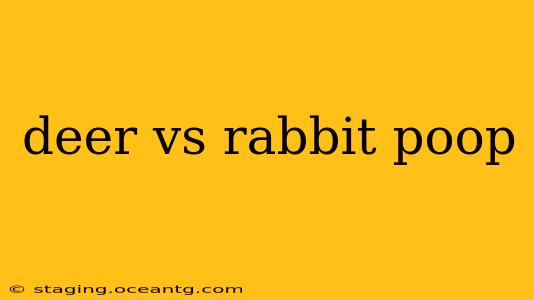Identifying animal scat can be a fascinating way to learn about the wildlife in your area. Two commonly encountered droppings belong to deer and rabbits, and while they might look similar at first glance, there are key differences that allow for accurate identification. This guide will delve into the nuances of deer and rabbit poop, equipping you with the knowledge to distinguish between the two.
What does deer poop look like?
Deer droppings, also known as pellets, are typically oval-shaped and about ½ inch long. They are dark brown to black in color, and their consistency varies depending on the deer's diet. Fresh deer droppings are often moist and dark, while older ones may be drier and lighter in color. They are usually clustered together in piles, and the size and shape of the pellets can slightly vary depending on the species of deer. The pellets are individually distinct and don't stick together.
What does rabbit poop look like?
Rabbit droppings are smaller and rounder than deer pellets, usually about ¼ inch in diameter. They are dark brown to black, and often appear dry and firm. Unlike deer droppings, rabbit pellets are generally scattered more randomly, and often individually, rather than clumped in piles. Their uniform size and shape are a distinguishing feature.
How can I tell the difference between deer and rabbit droppings?
The most significant differences lie in size and shape. Deer pellets are noticeably larger and oval, while rabbit pellets are smaller and rounder. The clustering of the droppings is also a useful indicator. Deer droppings are typically found in small piles, whereas rabbit droppings are more dispersed. Finally, consider the location. Rabbits often leave their droppings in well-used areas, whereas deer droppings might be scattered more widely across their range.
What are the common misconceptions about deer and rabbit droppings?
A common misconception is that all dark brown pellets are deer droppings. However, the size, shape, and clustering patterns are vital for accurate identification. Another misconception is that the smell will be definitive. While fresh droppings may have a discernible odor, this is not a reliable distinguishing factor.
How can I tell if deer or rabbit droppings are fresh?
Fresh deer and rabbit droppings are dark in color and moist to the touch. Older droppings will be drier, lighter in color, and may have bleached slightly from sun exposure.
What other animals might have similar droppings?
While deer and rabbit droppings are relatively distinct, other small mammals, like mice and voles, may produce similarly sized pellets. However, their droppings are typically much smaller and often contain plant matter that is readily visible.
Why is it important to identify animal droppings?
Identifying animal droppings is important for several reasons. It allows for monitoring wildlife populations, understanding their habitat use, and even detecting potential health issues within a population. Additionally, it's a fun and engaging way to connect with the natural world around you.
By considering the size, shape, clustering pattern, and overall context, you can confidently differentiate between deer and rabbit droppings, enriching your understanding of the natural world. Remember that practice makes perfect! The more you observe and compare, the easier it will become to identify these and other wildlife signs.
